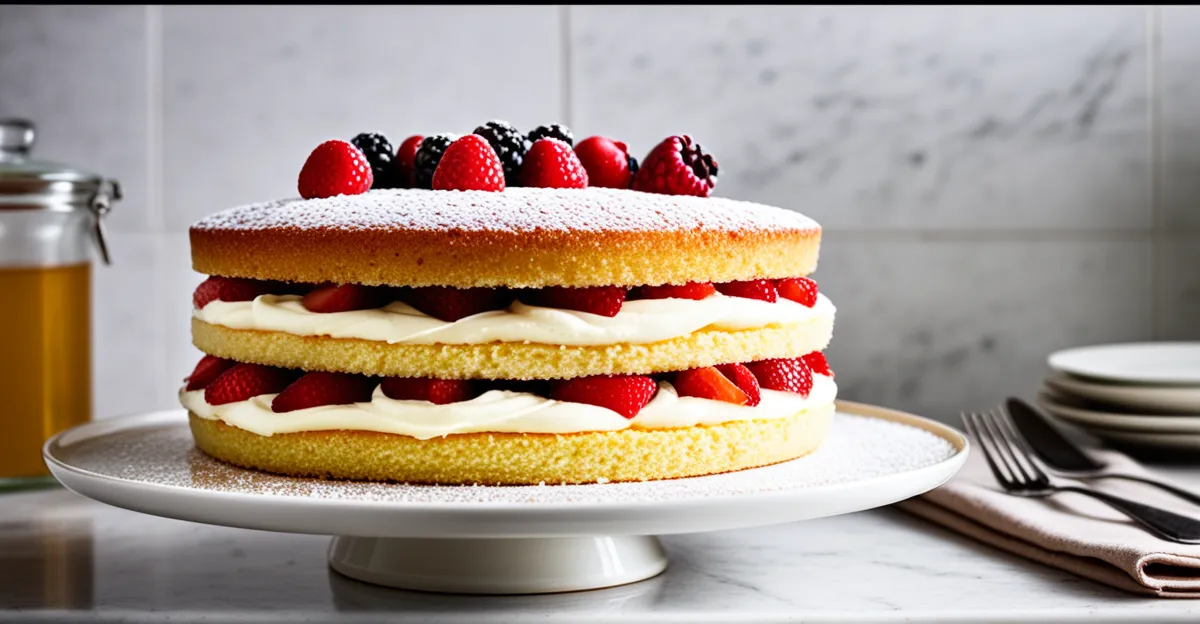Essential Ingredients and Measurements for a Perfect Victoria Sponge
Using quality ingredients is fundamental when crafting a Victoria sponge. Fresh eggs, unsalted butter, caster sugar, and self-raising flour ensure a light and tender crumb. These baking essentials create the cake’s characteristic texture and flavour. Selecting premium ingredients prevents bitterness or dryness, crucial for the sponge’s success.
Accurate measurements are equally important. Use digital scales to weigh ingredients precisely—volume measures often vary. For example, 200g of butter, 200g of caster sugar, 4 medium eggs, and 200g of self-raising flour provide the ideal ratio for a balanced sponge. This precision supports consistent rising and texture.
Also read : How can you create a perfect Yorkshire pudding?
Choosing the right baking equipment also influences results. Use two 8-inch round cake tins with a non-stick surface to ensure even cooking and easy release. Line tins with baking parchment for clean edges. A reliable oven thermometer helps maintain an exact temperature, avoiding under or overbaking.
Together, these measured Victoria sponge ingredients and baking essentials form the foundation. Attention to detail in the selection and measuring stage determines the sponge’s final lightness and flavour.
Topic to read : How can you make a flavorful beef Wellington at home?
Step-by-Step Method to Achieve Flawless Sponge Texture
Master the baking process with precise techniques
The Victoria sponge recipe relies heavily on mastering the creaming method. Start by beating the softened butter and caster sugar together until pale and fluffy. This introduces air, vital for a light sponge texture. Using an electric mixer on medium speed ensures even incorporation without overworking.
Next, add eggs one at a time, mixing well after each addition. Accurate measurements here matter—too much liquid disrupts the balance and can cause sinking. Then, gently fold in self-raising flour using a spatula. The folding technique is essential; it combines ingredients without knocking out aeration, preserving lightness. Over-mixing can make the sponge dense and rubbery.
For even baking, divide the batter equally between your lined tins. Level the surface carefully with a spatula to prevent doming. This simple step ensures uniform rising and a smooth top, making assembly easier.
Following these step-by-step baking instructions builds the foundation for a tender, consistent sponge, allowing the natural flavours of your Victoria sponge ingredients to shine beautifully.
Baking, Cooling, and Troubleshooting Your Victoria Sponge
Ensure perfect results from oven to table
Baking a Victoria sponge requires precise oven temperature control, typically set to 180°C (350°F) for about 20-25 minutes. An oven temperature too high causes a burnt crust with an undercooked centre; too low leads to a dense, pale sponge. Use an oven thermometer for accurate baking temperatures—a vital baking essential.
Once baked, cool the sponge in its tin for 5-10 minutes to stabilize its crumb. Then transfer it to a wire rack to cool completely. Cooling on a rack prevents sogginess by allowing air circulation under the cake base. This step is crucial; placing the sponge on a solid surface traps moisture.
Common issues include sinking sponges—usually caused by underbaking or overmixing batter, destroying aeration and resulting in dense texture. Flat sponges often arise from insufficient raising agents or batter being unevenly divided. Dry cakes can indicate overbaking or using ingredients measured inaccurately.
To troubleshoot, check for oven hot spots by rotating tins mid-bake. Also, monitor cake rise and texture during baking, adjusting time or heat as needed. Following these baking Victoria sponge tips helps avoid common faults and ensures a light, fluffy cake every time.
Classic Fillings and Authentic Presentation
Flavour pairing and assembly for timeless appeal
The Victoria sponge filling primarily consists of the traditional jam and cream combo—usually raspberry or strawberry jam and freshly whipped double cream. Why choose these? Raspberry jam adds tartness that cuts through the sweetness, while fresh cream offers a light, airy texture. This harmony elevates the cake’s flavour without overpowering the delicate sponge.
When assembling, spread a generous but even layer of jam on one sponge layer first. Next, add an equally smooth layer of whipped cream. This order ensures the jam adheres well and prevents slipping. Stack the second sponge carefully to maintain stability. Too much filling or uneven layering can cause the cake to sag or slide, detracting from appearance and eating experience.
To finish, dust the top with a light sprinkle of powdered sugar—an enduring hallmark of classic Victoria sponge filling. This simple touch adds elegance and a subtle sweetness. When slicing, use a serrated knife with a gentle sawing motion to keep clean edges without squashing the layers.
Mastering these key steps in filling and presentation transforms homemade Victoria sponge into a refined dessert worthy of any occasion.
Expert Tips and Visual Aids for Mastery
Take your Victoria sponge to the next level
Mastering the Victoria sponge demands a blend of skill and insight. Expert advice highlights the importance of controlling every stage, from precise mixing to accurate oven temperature. For example, batch baking consistently requires scrupulous attention to ingredient ratios and timing to ensure each sponge layer rises evenly and retains softness.
Baking tips emphasize using an electric mixer with speed control for the creaming step, and gentle folding with a spatula to prevent batter deflation. Testing doneness by lightly pressing the sponge’s surface provides a reliable cue—springy texture signals readiness, avoiding overbaking.
Visual cake guides are invaluable. Photo sequences can illustrate critical steps like folding technique or batter levelling, offering clear benchmarks. Video demos make expert techniques accessible, showing real-time mixing speed or how to rotate tins mid-bake to counter hot spots.
While maintaining authenticity, these resources empower bakers to adjust details like filling thickness or dusting intensity confidently. Combining Victoria sponge expert advice with visual aids transforms learning into an engaging, practical experience, facilitating consistent, delicious results every time.









